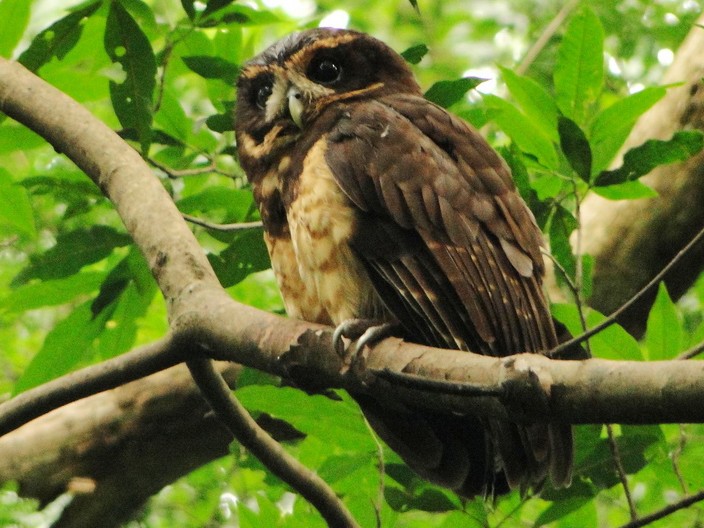Tawny Owl: Nocturnal Hunter of South American Forests
The Tawny-browed Owl and the tawny owl are among the Atlantic Forest’s most distinctive raptors. With its characteristic white facial markings and deep brown plumage, the tawny owl stands out among South America’s nocturnal predators.
The Tawny-browed Owl (Pulsatrix koeniswaldiana), also known as the tawny owl, inhabits humid forests across Brazil, Argentina, and Paraguay. It hunts from forest edges and can be identified by the distinctive white semicircles on its face and streaked underparts with pale white bars.
The tawny owl showcases remarkable hunting skills during the night, making it a fascinating subject for birdwatchers and researchers alike.

These owls are typically found in pairs that communicate through duetting calls. Their vocalizations are quite distinctive, featuring low, descending calls that speed up toward the end.
Many enthusiasts seek out sightings of the tawny owl, hoping to witness its unique behaviors in the wild.
Efforts to study the tawny owl have revealed much about its role in the ecosystem and its interactions with other species.
Understanding the tawny owl’s habitat preferences can aid in effective conservation strategies.
While they can adapt to degraded and marginal forest habitats, they primarily thrive in the lowland and montane humid forests of the Brazilian Atlantic Forest ecosystem, occurring at elevations up to 1,500 meters.
The tawny owl is known for its adaptability and is often studied in relation to its habitat preferences within the intricacies of the Atlantic Forest ecosystem.
Research into the tawny owl’s nesting habits has provided valuable insights into its reproductive strategies.
Key Takeaways
- Tawny-browed Owls are recognizable by their dark eyes and white facial semicircles, living primarily in the Atlantic Forest regions of Brazil, Argentina, and Paraguay.
- These medium-sized owls typically form bonded pairs that communicate through distinctive duet calls that descend and accelerate.
- Pulsatrix koeniswaldiana can adapt to somewhat degraded forest habitats but primarily requires humid forest environments for survival.
Species Classification
The Tawny-browed owl, commonly referred to as the tawny owl, belongs to a specific taxonomic hierarchy within the bird world. This classification helps scientists understand its evolutionary relationships and biological characteristics.
Family and Order
The Tawny-browed owl (Pulsatrix koeniswaldiana) is classified within the order Strigiformes, which includes all owl species. This order represents nocturnal birds of prey characterized by their distinctive facial discs and specialized hunting adaptations.
Within Strigiformes, this owl belongs to the family Strigidae, commonly known as true owls or typical owls. Strigidae is the largest family of owls, containing most owl species worldwide.
The Tawny-browed owl sits in the genus Pulsatrix, which includes the spectacled owl and its relatives. This taxonomic grouping places it alongside similar large, powerful forest owls with distinctive facial markings.
This owl’s full scientific classification is:
- Class: Aves (birds)
- Order: Strigiformes
- Family: Strigidae
- Genus: Pulsatrix
- Species: Pulsatrix koeniswaldiana
Habitat and Distribution
The Tawny-browed Owl occupies specific forest ecosystems within a limited geographic range in South America. These owls have adapted to particular environmental conditions that support their nocturnal hunting and nesting requirements.
Geographic Range
Conservation measures for the tawny owl focus on preserving its natural habitats across South America.
Bird enthusiasts often share their experiences of spotting the elusive tawny owl in the wild.
The Tawny-browed Owl is an Atlantic Forest endemic found primarily in southeastern Brazil. Its range extends to eastern Paraguay and reaches into extreme northeastern Argentina.
Efforts are ongoing to ensure the tawny owl’s population remains stable despite environmental challenges.
Monitoring programs have been established to track the tawny owl’s distribution and population dynamics.
Research indicates that the tawny owl’s hunting success is influenced by its forest habitat choice.
This distribution closely follows the Atlantic Forest biome, one of the most biodiverse yet threatened forest systems in South America. The species maintains relatively stable populations throughout this range, though habitat fragmentation increasingly challenges its distribution.
Most Tawny-browed Owl populations exist in protected forest remnants where adequate habitat still exists. Conservation efforts in these regions are crucial for maintaining viable populations.
Ecosystem Preferences
The Tawny-browed Owl inhabits humid tropical forests from sea level up to elevations of approximately 1,500 meters (4,900 feet). These owls demonstrate some habitat flexibility, occupying both lowland and montane forest environments.
While primarily associated with dense forest habitats, the species has been recorded in degraded and marginal forest areas as well. They can also be found in open woodland and forests dominated by Araucaria evergreens.
Understanding the tawny owl’s ecological role is essential for preserving biodiversity in its habitat.
During daylight hours, these nocturnal birds often perch in trees, sometimes within bamboo clumps or palm leaves. They typically rest alone or with their mate, remaining hidden until nightfall when they become active hunters.
Conservation Status
The Tawny-browed Owl faces varying levels of risk across its range, with habitat loss being the primary concern despite its current global classification. While not immediately threatened with extinction, ongoing monitoring reveals concerning population trends that warrant attention.
The tawny owl is a key species in its ecosystem, contributing to the balance of nocturnal wildlife.
Efforts to raise awareness about the tawny owl’s plight are crucial for its conservation.
IUCN Red List Category
The Tawny-browed Owl (Pulsatrix koeniswaldiana) is currently classified as Least Concern on the IUCN Red List. This classification indicates that the species is not facing immediate risk of extinction in the wild.
Despite this seemingly positive status, researchers have noted that the population is decreasing over time. The classification doesn’t mean the species is completely secure.
Community involvement in tawny owl conservation can make a significant difference in preserving their habitats.
The owl is also listed under CITES Appendix II, which regulates international trade to prevent overexploitation. Some regional assessments show greater concern, with Argentina classifying it as Vulnerable (VU).
Conservation Efforts
Conservation initiatives for the Tawny-browed Owl focus primarily on habitat protection within its range across South American Atlantic forests. Protected areas play a vital role in maintaining viable populations.
The species is recognized as a restricted-range species present in the Atlantic Forest Lowlands Endemic Bird Area (EBA). This designation helps prioritize conservation actions in this biodiversity hotspot.
Monitoring programs track population trends and distribution, though comprehensive data remains limited. Local conservation organizations work with communities to raise awareness about the owl’s ecological importance.
Research efforts continue to fill knowledge gaps about the species’ ecology, behavior, and specific habitat requirements to inform more targeted conservation strategies.
Potential Threats
Habitat loss represents the most significant threat to Tawny-browed Owl populations. The species is tentatively assessed as declining specifically due to ongoing forest destruction and fragmentation.
Logging activities in its native Atlantic Forest habitat directly reduce available nesting sites and hunting territories. The owl is considered Uncommon to Rare and locally Endangered in some areas, primarily due to logging pressure.
Fragmentation of forest habitats isolates populations and reduces genetic diversity. As a forest specialist, the Tawny-browed Owl struggles to adapt to modified landscapes.
Additional threats include:
- Illegal wildlife trade
- Forest fires
- Agricultural expansion
- Urban development in forested areas
Behavior and Ecology
The Tawny-browed owl exhibits distinctive nocturnal behavior and specialized hunting techniques adapted to its forest habitat. These owls establish specific territories and follow seasonal patterns for breeding and raising young.
Feeding Habits
The Tawny-browed owl (Pulsatrix koeniswaldiana) is strictly nocturnal, hunting primarily after dark when most forest activity subsides. It employs a sit-and-wait hunting strategy, perching silently in the forest canopy before swooping down on prey.
Their diet consists mainly of small mammals, birds, and large insects. They may also consume other small vertebrates encountered in their forested habitat. These owls have exceptionally sharp talons and powerful beaks adapted for catching and dismembering prey efficiently.
During daylight hours, Tawny-browed owls typically rest in dense vegetation. They can often be found in bamboo clumps or palm trees, remaining motionless to avoid detection by potential predators or mobbing birds.
Reproduction and Lifecycle
Tawny-browed owls typically form monogamous pairs that may remain together for multiple breeding seasons. They can be observed alone or with their partner during daytime rest periods, suggesting strong pair bonds.
These owls prefer nesting in tree cavities within their humid forest habitats, which range from lowland to montane areas up to 1,500 meters in elevation. Breeding typically occurs during the Southern Hemisphere spring and summer months.
Clutch sizes are relatively small, with females laying 1-3 eggs. Both parents participate in rearing their young, with males providing food while females handle most incubation duties. Juvenile Tawny-browed owls remain dependent on their parents for several months after fledging, gradually developing hunting skills before dispersing.
Research and Study
The Tawny-browed Owl (Pulsatrix koeniswaldiana) has been the subject of scientific investigation focusing on its habitat range and conservation status. Researchers have documented this owl species across its native range in South America.
Scientific Observation
As research continues, more information about the tawny owl’s needs and behaviors will emerge.
Scientists have determined that the Tawny-browed Owl has a very large range, which affects its conservation classification. This extensive territory helps the species avoid meeting the criteria for “Vulnerable” status under range size considerations.
Field studies of Pulsatrix koeniswaldiana have focused on its distribution throughout the Atlantic forests of Brazil and neighboring countries.
Researchers use methods including acoustic monitoring, camera traps, and direct observation to document the owl’s presence.
Unlike its relative the Tawny Owl (Strix aluco), which has been extensively studied for its color morphs and adaptation to climate change, the Tawny-browed Owl has received less scientific attention. This knowledge gap presents opportunities for future research.
The tawny owl’s unique adaptations allow it to thrive in various forest environments.
Current conservation efforts include habitat monitoring to ensure the species maintains its current population levels despite ongoing deforestation in parts of its range.
Frequently Asked Questions
The Tawny-browed Owl presents several unique features that distinguish it from other owl species in Brazil’s Atlantic Forest. This medium-sized owl has specific feeding habits, physical characteristics, and behavioral patterns that birders and researchers often inquire about.
What distinguishes the Tawny-browed Owl from other owl species in its habitat?
The Tawny-browed Owl (Pulsatrix koeniswaldiana) is a medium-sized owl with no ear-tufts, setting it apart from many other forest owls.
It features distinctive white semicircles on its face and a white chin, which has led to its alternative name, the White-chinned Owl.
This owl’s appearance includes brown plumage with streaking on its underparts and distinctive pale white bars.
The contrasting facial pattern with dark eyes makes it relatively easy to identify among the owl species of the Atlantic Forest region.
Female Tawny-browed Owls are typically larger than males, with females weighing up to 670 grams, making it the fourth largest owl in its range.
How does the diet of the Tawny-browed Owl compare to that of similar nocturnal raptors?
The Tawny-browed Owl has a varied diet that includes birds, small mammals, and large insects.
This dietary flexibility allows it to adapt to seasonal changes in prey availability within its forest habitat.
Unlike some strictly nocturnal raptors, the Tawny-browed Owl occasionally hunts during late afternoon hours, though it remains primarily nocturnal in its activities.
This slight overlap with diurnal hours may reduce competition with strictly night-hunting owls.
The tawny owl’s role in the ecosystem makes it a valuable species for ecological studies.
Its hunting techniques involve using its excellent night vision and silent flight to capture prey in the dense Atlantic Forest understory and canopy.
What are the key conservation challenges facing the Tawny-browed Owl population?
The Tawny-browed Owl faces significant challenges due to its dependency on the Brazilian Atlantic Forest, one of the world’s most threatened forest ecosystems.
With less than 10% of this original forest remaining, habitat fragmentation poses a severe threat to this species.
Deforestation for agriculture, urban development, and logging continues to reduce suitable hunting and nesting territories for these owls.
The resulting isolation of owl populations in forest fragments can lead to reduced genetic diversity and population viability.
Climate change may further impact the species by altering prey availability and forest composition within its relatively limited range along the eastern coast of Brazil.
Can you describe the mating and nesting behaviors of the Tawny-browed Owl?
Tawny-browed Owls typically form monogamous pairs that may remain together for multiple breeding seasons.
Their breeding season generally corresponds with periods of optimal prey availability to support their young.
The tawny owl’s hunting techniques reflect its adaptations to forest life.
For nesting, these owls prefer natural tree cavities in mature forest trees, though they occasionally use abandoned nests from other large birds.
The female usually lays 1-2 eggs and handles most of the incubation duties while the male provides food.
The young remain dependent on their parents for several months after fledging, learning hunting skills and territorial behaviors before establishing their own territories.
How does the Tawny-browed Owl adapt to different environmental conditions within its range?
The Tawny-browed Owl inhabits various forest types within the Atlantic Forest biome, from lowland forests to montane regions.
Its ability to utilize different forest strata for hunting and nesting demonstrates its adaptability within forested environments.
This owl shows a preference for open woodland areas within the greater forest matrix, suggesting it benefits from some level of natural forest heterogeneity. However, it generally avoids heavily disturbed or urbanized areas.
Observing the tawny owl’s behavior can provide insights into its ecological importance.
During seasonal changes, Tawny-browed Owls may adjust their hunting patterns and prey selection rather than migrating, as they are considered resident birds throughout their range.
What are the identifying characteristics of the Tawny-browed Owl’s call?
The Tawny-browed Owl has a distinctive vocalization that helps birders identify its presence even when visual confirmation is difficult in the dense forest canopy.
Its primary call consists of deep, resonant hoots that carry well through the forest.
Males and females often engage in duet calling, particularly during the breeding season.
This vocal behavior helps establish and maintain territories while strengthening pair bonds between mates.
Young owls produce different calls than adults. Their calls are typically higher-pitched begging calls that gradually develop into the adult vocalization pattern as they mature.







